Enhanced cognitive activity--over and above social or physical activity--is required to protect Alzheimer's mice against cognitive impairment, reduce Abeta deposition, and increase synaptic immunoreactivity
- PMID: 17714960
- PMCID: PMC2083653
- DOI: 10.1016/j.nlm.2007.07.007
Enhanced cognitive activity--over and above social or physical activity--is required to protect Alzheimer's mice against cognitive impairment, reduce Abeta deposition, and increase synaptic immunoreactivity
Abstract
Although social, physical, and cognitive activities have each been suggested to reduce the risk of Alzheimer's disease (AD), epidemiologic studies cannot determine which activity or combination of activities is most important. To address this question, mutant APP transgenic AD mice were reared long-term in one of four housing conditions (impoverished, social, social+physical, or complete enrichment) from 1(1/2) through 9 months of age. Thus, a stepwise layering of social, physical, and enhanced cognitive activity was created. Behavioral evaluation in a full battery of sensorimotor, anxiety, and cognitive tasks was carried out during the final 5 weeks of housing. Only AD mice raised in complete enrichment (i.e., enhanced cognitive activity) showed: (1) protection against cognitive impairment, (2) decreased brain beta-amyloid deposition, and (3) increased hippocampal synaptic immunoreactivity. The protection provided by enhanced cognitive activity spanned multiple cognitive domains (working memory, reference learning, and recognition/identification). Cognitive and neurohistologic benefits of complete enrichment occurred without any changes in blood cytokine or corticosterone levels, suggesting that enrichment-dependent mechanisms do not involve changes in the inflammatory response or stress levels, respectively. These results indicate that the enhanced cognitive activity of complete enrichment is required for cognitive and neurologic benefit to AD mice-physical and/or social activity are insufficient. Thus, our data suggest that humans who emphasize a high lifelong level of cognitive activity (over and above social and physical activities) will attain the maximal environmental protection against AD.
Figures

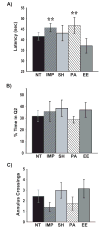
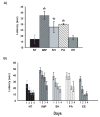
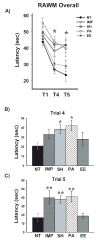
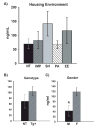
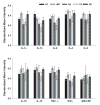
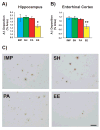
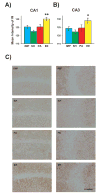
Similar articles
-
Lifelong immunization with human beta-amyloid (1-42) protects Alzheimer's transgenic mice against cognitive impairment throughout aging.Neuroscience. 2005;130(3):667-84. doi: 10.1016/j.neuroscience.2004.09.055. Neuroscience. 2005. PMID: 15590151
-
Environmental enrichment lessens cognitive decline in APP23 mice without affecting brain sirtuin expression.J Alzheimers Dis. 2014;42(3):851-64. doi: 10.3233/JAD-131430. J Alzheimers Dis. 2014. PMID: 24961946
-
A diet high in omega-3 fatty acids does not improve or protect cognitive performance in Alzheimer's transgenic mice.Neuroscience. 2007 Oct 26;149(2):286-302. doi: 10.1016/j.neuroscience.2007.08.018. Epub 2007 Aug 14. Neuroscience. 2007. PMID: 17904756
-
Physical exercise protects against Alzheimer's disease in 3xTg-AD mice.J Alzheimers Dis. 2011;24(3):421-54. doi: 10.3233/JAD-2011-101635. J Alzheimers Dis. 2011. PMID: 21297257
-
Beneficial Effects of Walnuts on Cognition and Brain Health.Nutrients. 2020 Feb 20;12(2):550. doi: 10.3390/nu12020550. Nutrients. 2020. PMID: 32093220 Free PMC article. Review.
Cited by
-
Granulocyte colony stimulating factor decreases brain amyloid burden and reverses cognitive impairment in Alzheimer's mice.Neuroscience. 2009 Sep 29;163(1):55-72. doi: 10.1016/j.neuroscience.2009.05.071. Epub 2009 Jun 14. Neuroscience. 2009. PMID: 19500657 Free PMC article.
-
Lifespan mental activity predicts diminished rate of hippocampal atrophy.PLoS One. 2008 Jul 9;3(7):e2598. doi: 10.1371/journal.pone.0002598. PLoS One. 2008. PMID: 18612379 Free PMC article.
-
Novel therapies for combating chronic neuropathological sequelae of TBI.Neuropharmacology. 2019 Feb;145(Pt B):160-176. doi: 10.1016/j.neuropharm.2018.06.021. Epub 2018 Jun 20. Neuropharmacology. 2019. PMID: 29933008 Free PMC article. Review.
-
Interactions between stress and physical activity on Alzheimer's disease pathology.Neurobiol Stress. 2018 Feb 22;8:158-171. doi: 10.1016/j.ynstr.2018.02.004. eCollection 2018 Feb. Neurobiol Stress. 2018. PMID: 29888311 Free PMC article. Review.
-
Measuring target effect of proposed disease-modifying therapies in Alzheimer's disease.Neurotherapeutics. 2008 Jul;5(3):381-90. doi: 10.1016/j.nurt.2008.05.009. Neurotherapeutics. 2008. PMID: 18625449 Free PMC article. Review.
References
-
- Abbott R, White L, Ross G, Masaki K, Curb J, Petrovitch H. Walking and dementia in physically capable elderly men. Journal of the American Medical Association. 2004;292:1447–1453. - PubMed
-
- Altepeter T, Adams R, Buchana W, Buck P. Luria memory words test and Wechsler memory scale: comparison of utility in discriminating neurologically impaired from controls. Journal of Clinical Psychology. 1990;46:190–193. - PubMed
-
- Anderson B, Rapp D, Baek D, McCloskey D, Coburn-Litvak P, Robinson J. Exercise influences spatial learning in the radial arm maze. Physiology and Behavior. 2000;70:425–429. - PubMed
Publication types
MeSH terms
Substances
Grants and funding
LinkOut - more resources
Full Text Sources
Medical
Molecular Biology Databases

